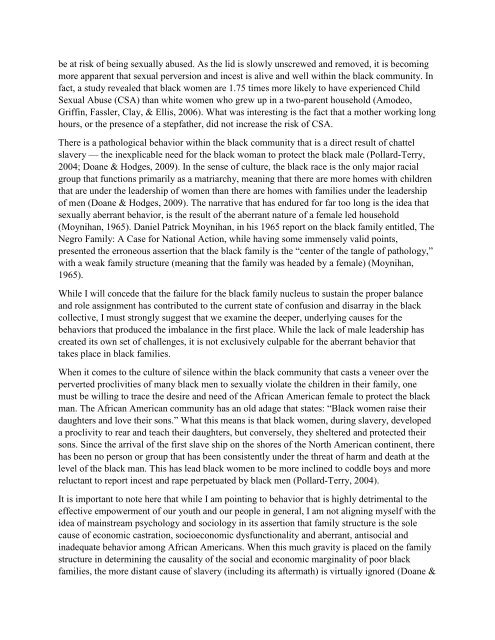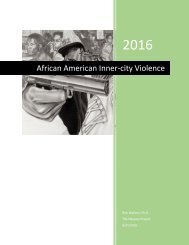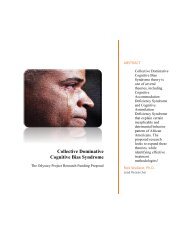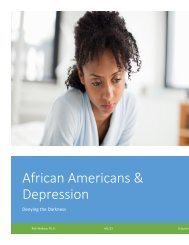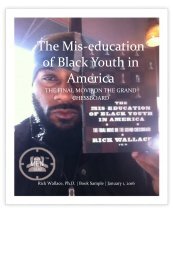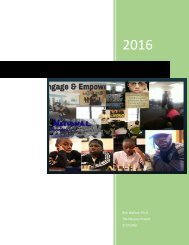Molestation, Incest and Rape in African American Families
While the subject of child molestation and incest remain a taboo topic, within the African American collective, its prevalence and impact can no longer be ignored. When perusing psychology textbooks on incest and molestation, especially the older ones, it is easy for a psychology student to develop an impression that molestation, incest and rape within the family environment is extremely rare; however, when engaging professional therapists (psychiatrists, psychologist, cognitive therapists, etc.) on the matter, it becomes obvious that this type of trauma is immensely prevalent, but that it also has an immense impact on the long-term success of the victim. The purpose of this brief treatise on this particular topic is to expand the superficial knowledge on the subject, while illuminating the manner in which this type of trauma can negatively impact the life of the victim and those within their periphery.
While the subject of child molestation and incest remain a taboo topic, within the African American collective, its prevalence and impact can no longer be ignored. When perusing psychology textbooks on incest and molestation, especially the older ones, it is easy for a psychology student to develop an impression that molestation, incest and rape within the family environment is extremely rare; however, when engaging professional therapists (psychiatrists, psychologist, cognitive therapists, etc.) on the matter, it becomes obvious that this type of trauma is immensely prevalent, but that it also has an immense impact on the long-term success of the victim. The purpose of this brief treatise on this particular topic is to expand the superficial knowledge on the subject, while illuminating the manner in which this type of trauma can negatively impact the life of the victim and those within their periphery.
Create successful ePaper yourself
Turn your PDF publications into a flip-book with our unique Google optimized e-Paper software.
e at risk of be<strong>in</strong>g sexually abused. As the lid is slowly unscrewed <strong>and</strong> removed, it is becom<strong>in</strong>g<br />
more apparent that sexual perversion <strong>and</strong> <strong>in</strong>cest is alive <strong>and</strong> well with<strong>in</strong> the black community. In<br />
fact, a study revealed that black women are 1.75 times more likely to have experienced Child<br />
Sexual Abuse (CSA) than white women who grew up <strong>in</strong> a two-parent household (Amodeo,<br />
Griff<strong>in</strong>, Fassler, Clay, & Ellis, 2006). What was <strong>in</strong>terest<strong>in</strong>g is the fact that a mother work<strong>in</strong>g long<br />
hours, or the presence of a stepfather, did not <strong>in</strong>crease the risk of CSA.<br />
There is a pathological behavior with<strong>in</strong> the black community that is a direct result of chattel<br />
slavery — the <strong>in</strong>explicable need for the black woman to protect the black male (Pollard-Terry,<br />
2004; Doane & Hodges, 2009). In the sense of culture, the black race is the only major racial<br />
group that functions primarily as a matriarchy, mean<strong>in</strong>g that there are more homes with children<br />
that are under the leadership of women than there are homes with families under the leadership<br />
of men (Doane & Hodges, 2009). The narrative that has endured for far too long is the idea that<br />
sexually aberrant behavior, is the result of the aberrant nature of a female led household<br />
(Moynihan, 1965). Daniel Patrick Moynihan, <strong>in</strong> his 1965 report on the black family entitled, The<br />
Negro Family: A Case for National Action, while hav<strong>in</strong>g some immensely valid po<strong>in</strong>ts,<br />
presented the erroneous assertion that the black family is the “center of the tangle of pathology,”<br />
with a weak family structure (mean<strong>in</strong>g that the family was headed by a female) (Moynihan,<br />
1965).<br />
While I will concede that the failure for the black family nucleus to susta<strong>in</strong> the proper balance<br />
<strong>and</strong> role assignment has contributed to the current state of confusion <strong>and</strong> disarray <strong>in</strong> the black<br />
collective, I must strongly suggest that we exam<strong>in</strong>e the deeper, underly<strong>in</strong>g causes for the<br />
behaviors that produced the imbalance <strong>in</strong> the first place. While the lack of male leadership has<br />
created its own set of challenges, it is not exclusively culpable for the aberrant behavior that<br />
takes place <strong>in</strong> black families.<br />
When it comes to the culture of silence with<strong>in</strong> the black community that casts a veneer over the<br />
perverted proclivities of many black men to sexually violate the children <strong>in</strong> their family, one<br />
must be will<strong>in</strong>g to trace the desire <strong>and</strong> need of the <strong>African</strong> <strong>American</strong> female to protect the black<br />
man. The <strong>African</strong> <strong>American</strong> community has an old adage that states: “Black women raise their<br />
daughters <strong>and</strong> love their sons.” What this means is that black women, dur<strong>in</strong>g slavery, developed<br />
a proclivity to rear <strong>and</strong> teach their daughters, but conversely, they sheltered <strong>and</strong> protected their<br />
sons. S<strong>in</strong>ce the arrival of the first slave ship on the shores of the North <strong>American</strong> cont<strong>in</strong>ent, there<br />
has been no person or group that has been consistently under the threat of harm <strong>and</strong> death at the<br />
level of the black man. This has lead black women to be more <strong>in</strong>cl<strong>in</strong>ed to coddle boys <strong>and</strong> more<br />
reluctant to report <strong>in</strong>cest <strong>and</strong> rape perpetuated by black men (Pollard-Terry, 2004).<br />
It is important to note here that while I am po<strong>in</strong>t<strong>in</strong>g to behavior that is highly detrimental to the<br />
effective empowerment of our youth <strong>and</strong> our people <strong>in</strong> general, I am not align<strong>in</strong>g myself with the<br />
idea of ma<strong>in</strong>stream psychology <strong>and</strong> sociology <strong>in</strong> its assertion that family structure is the sole<br />
cause of economic castration, socioeconomic dysfunctionality <strong>and</strong> aberrant, antisocial <strong>and</strong><br />
<strong>in</strong>adequate behavior among <strong>African</strong> <strong>American</strong>s. When this much gravity is placed on the family<br />
structure <strong>in</strong> determ<strong>in</strong><strong>in</strong>g the causality of the social <strong>and</strong> economic marg<strong>in</strong>ality of poor black<br />
families, the more distant cause of slavery (<strong>in</strong>clud<strong>in</strong>g its aftermath) is virtually ignored (Doane &


